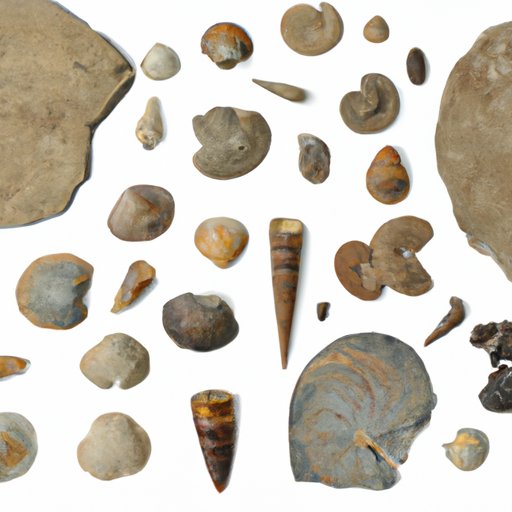Introduction
Fossils provide crucial insights into the history of life on Earth, but they can only be found in certain types of rocks. Unfortunately, not everyone knows which rocks to look for. In this article, we will explore which types of rocks are most likely to contain fossils and how to identify them. We will also discuss the process of fossil excavation and why understanding the relationship between sedimentary rocks and fossils is essential to our understanding of evolution.
The relationship between fossils and sedimentary rocks
Fossils are most commonly found in sedimentary rocks, which are created by the accumulation of sediment over time. The process starts with the erosion and weathering of rocks and minerals, resulting in the formation of loose sediment. This sediment is then transported by wind, water, or ice and deposited in new locations.
Over time, the layers of sediment are compacted and cemented together to form rock. This process creates distinct layers, or strata, in the rock, with each layer representing a particular time period. Fossils are formed when dead plant or animal matter becomes trapped in the sediments and is buried. Over time, the organic material decomposes, leaving behind a solid mineral replica of the original organism.
Different types of organisms leave behind different types of fossils. For example, hard-shelled organisms like clams and snails are more likely to leave behind fossils than soft-bodied creatures like jellyfish. Bones and teeth from vertebrate animals are also common fossils found in sedimentary rocks.
Fossil hunting: A guide to finding and identifying fossil-rich sedimentary rocks
Identifying sedimentary rocks that are likely to contain fossils can be a challenge, but there are some tips and tricks you can use. Look for rocks with distinct layers, as these are more likely to contain fossils. Also, look for rocks that have a fine-grained texture, as this indicates that the sediment was deposited slowly, allowing for better preservation of fossils.
Common locations where fossil-rich rocks can be found include riverbeds, quarries, and cliffs. Areas that were once covered by water, such as lakebeds and ocean floors, are also good places to look for fossils.
Different types of rocks and their contribution to fossil discovery: a comparative analysis
While fossils are most commonly found in sedimentary rocks, they can also be found in metamorphic and igneous rocks. However, the types of fossils found in these rocks are usually limited to the remains of plants and animals that were present when the rock was formed.
Sedimentary rocks are by far the most valuable for fossil discovery, as they provide a continuous record of the earth’s history. Metamorphic and igneous rocks are formed through heat and pressure, which can destroy any fossils that may have been present.
Geologic processes also play a vital role in fossil preservation. Rapid burial and the absence of scavengers and oxygen are crucial factors in preserving soft tissues, while slow burial and exposure to oxygen can lead to rapid decay.
The excavation of fossils from sedimentary rocks: A fascinating journey through time
Fossil excavation is a delicate and complicated process that requires specialized equipment and methods. Paleontologists use a variety of tools, including chisels, hammers, and brushes, to carefully extract fossils from the surrounding rock.
Before excavation can begin, the paleontologist must first locate the fossils and determine their orientation. They then create a detailed map of the site and carefully remove the surrounding sediment to expose the fossil. Once the fossil is exposed, it is carefully extracted from the surrounding rock and transported to a laboratory for further analysis.
Excavating fossils from sedimentary rocks can take years or even decades, but the results can be truly breathtaking. Fossils provide a glimpse into the distant past and allow us to observe the evolution of life on Earth over millions of years.
The connection between the age of sedimentary rocks and the type of fossils they contain
The age of sedimentary rocks can provide clues about the types of organisms that lived during that time. Paleontologists use a technique called relative dating to determine the age of sedimentary rocks based on their position relative to other rock layers.
Relative dating allows paleontologists to create a timeline of the earth’s history and determine when different types of organisms first appeared. For example, the first land plants appeared during the Silurian period, which lasted from 443 to 416 million years ago.
The significance of fossils found in sedimentary rocks in understanding the evolution of life on Earth
Fossils provide crucial insights into the history of life on Earth and have played a vital role in shaping our understanding of evolution. The discovery of transitional species like Archaeopteryx, which had both bird and reptilian characteristics, provided evidence for the theory of evolution and helped to bridge the gap between birds and dinosaurs.
Fossils also allow us to study the diversity of life through time, track the development of specific species, and understand the impact of mass extinctions on the evolution of life. Without fossils, our understanding of the history of life on Earth would be greatly limited.
Conclusion
Fossils are only found in certain types of rocks, and understanding which rocks to look for is essential for anyone interested in paleontology. Sedimentary rocks are by far the most valuable for fossil discovery, but the excavation process is delicate and complicated. By understanding the relationship between sedimentary rocks and fossils, we can gain a better understanding of the evolution of life on Earth and the history of our planet.
